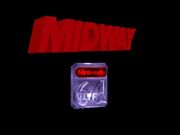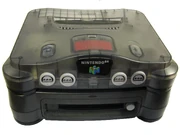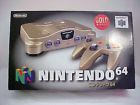m (Fixed) Tags: Visual edit apiedit |
(Adding categories) Tag: categoryselect |
||
| Line 108: | Line 108: | ||
[[Category:Nintendo 64]] |
[[Category:Nintendo 64]] |
||
[[Category:Nintendo 64 peripherals]] |
[[Category:Nintendo 64 peripherals]] |
||
| + | [[Category:Consoles]] |
||
Revision as of 17:33, 20 December 2015
|
The Nintendo 64 (Japanese: ニンテンドウろくよん, Nintendō Rokuyon), often abbreviated to N64 and stylised as NINTENDO⁶⁴, was Nintendo's third major home video game console. "Project: Reality" was the code-name of the console being worked on by Nintendo and Silicon Graphics (SGI) in April of 1993 to create a next-generation 3D console.
The console leaped from 16 bit sprite-based graphics into a polygon world thanks to its powerful 64-bit CPU and GPU, thus giving the console its name. The Nintendo 64 was Nintendo's last home console to use cartridges, though Nintendo's handhelds would continue to support the format.
The decision to choose cartridges over CD's did make quite a few third-party developers to turn away from the system all together. Not only were cartridges more expensive and had less capacity than CDs, but it also meant that Nintendo would be the only supplier, enforcing their grip on licenses. Nintendo's defense was to say that cartridges were still the media of choice for home consoles because they did not suffer from slow loading times and were somewhat more practical than CD's.
The Nintendo 64 was first released on June 23, 1996 in Japan. Among the consoles of the time, it was the only true 64-bit system and the first with built-in four player gaming. Masterpieces such as Super Mario 64, The Legend of Zelda: Ocarina of Time, Super Smash Bros. and GoldenEye 007 helped sell over 32 million N64 systems worldwide, though it wasn't enough to surpass the PlayStation. Nevertheless, the Nintendo 64 did make its mark on history with its innovative controller and true 3D capabilities.
History
In 1993, the Nintendo 64 was started as "Project: Reality". This venture, with the help of Silicon Graphics, was intended to create a graphics processor that would send video games into the 3D realm, confident that it would appeal to fans of CGI, especially since CGI-heavy movies like Jurassic Park and Terminator were becoming increasingly popular partly because of this new technology.

An early screenshot with the "Ultra 64" logo
Nintendo had recently cut off a deal with Sony to create a CD based console called the PlayStation due to the fact that Nintendo wouldn't have full control over the games on it, and thus went back to the "tried-and-true" cartridge route, disappointing both fans and developers! The next year Nintendo changed the name to the Ultra 64, though because Konami, another game developer, had already copyrighted the name for various NES titles.
Nintendo had to drop the title and thus changed it to the Nintendo 64. Nintendo had hoped to release the console in 1995, though had to delay it, causing it to be released long after the Sega Saturn and Sony PlayStation had been released. It wasn't even playable until late 1995 in Japan and a few months later in America at E3.
When a small stream of video games were announced for the console compared to that of the PlayStation's, Nintendo delivered the ever popular "quality vs. quantity" statement. Arguably this was true - many of their games have been highly praised, with even The Legend of Zelda: Ocarina of Time to this day being the highest rated video game of all time on GameRankings, and Super Mario 64 close behind it.
The aforementioned Super Mario 64 complimented the launch of the console along with other titles that were dwarfed by the shear scale of the newest Mario platform video game that set the standard for all future 3D platformers and, in a sense, the entire action adventure genre as well with its fantastic camera. The Nintendo 64 along with Mario, Pilotwings 64 and the negligible Saikyo Habu Shogi were all present during the Japanese launch of the game, which proved successful enough.
It was even more successful in America with an appealing $199 price tag as well as plenty of other games that would be released throughout the year that sported popular brand names including Star Wars, Mortal Kombat, Turok, Killer Instinct and Wave Race.
Because of the aforementioned titles, primarily Super Mario 64, it sold out entirely in America. The consoles were sold approximately three days earlier than scheduled.
Games
See: List of Nintendo 64 games
Top Ten N64 Best Sellers
- Super Mario 64
- Mario Kart 64
- GoldenEye 007
- The Legend of Zelda: Ocarina of Time
- Super Smash Bros.
- Diddy Kong Racing
- Pokémon Stadium
- Donkey Kong 64
- The Legend of Zelda: Majora's Mask
- Star Fox 64
Nintendo 64 Disc Drive

The DD attatched to the N64
The Nintendo 64 Disk Drive, or Nintendo 64DD, is a disk drive for the Nintendo 64. The Disk Drive plugs into the N64's expansion port on the base of the system. It was much hyped around the time of the N64's launch, but it was never released outside of Japan.
Hardware
The following are the technical specifications for the Nintendo 64.

N64 chip set
- CPU: 64-bit RISC NEC VR4300 derivative, based on MIPS R4300i (93.75 MHz) / 64-bit data paths, registers with 5-stage pipelining
- Co-processor: 64-bit RISC (62.5 MHz)
- RAM: 4MB (36Mb) upgradeable to 8MB
- Graphics: Pixel Drawing Processor (RDP) built into co-processor
- Colors: 16.7 million (32,000 on screen)
- Polygons: 150,000 per second
- Resolution: 240i (most games), 480i (high-resolution mode)
- Sound: 16 to 24-channel 16-bit stereo (up to 100 PCM channels possible)
Colors
The Nintendo 64 hardware has four controller ports, which led Nintendo to develop different colored controllers to assist players who may find it difficulty to know which controller is in which slot. Nintendo did not release different colored controller in the previous generation. The initial batch of colors were completely solid and included the standard grey, red, dark green, yellow, black and dark blue. As time went on, Nintendo started to release other colors, some of which featured two different colors such as the black and grey one that was released alongside Mario Kart 64 (the top half was black while the bottom half was grey).

The success of different colored controllers can be attributed to Nintendo's decision to develop different colored consoles. Nintendo found it particularly successful to release transparent systems and controllers. Some of the transparent systems even had different colors, such as the pink system and blue system. In Japan, Nintendo released a transparent black system that came bundled with the Nintendo 64DD. The Japanese audience wanted a bundle that included both the system and the additional hardware at a low price, so Nintendo responded accordingly.
Nintendo of America eventually released a set of transparent Nintendo 64's with different colors. The colors were given unique names including grape, watermelon, fire, smoke, jungle green, and ice. Additionally, Nintendo released a special gold Nintendo 64 for the launch of The Legend of Zelda: Ocarina of Time.
Trivia
- Nintendo 64's additionally codename: Project Reality is before presenting to first game at Super Mario 64.
- Nintendo 64's perviously codename: Ultra 64 was developed by Midway.
- The console, then known as "NU 64", was featured on the cover of Nintendo Power V80.
